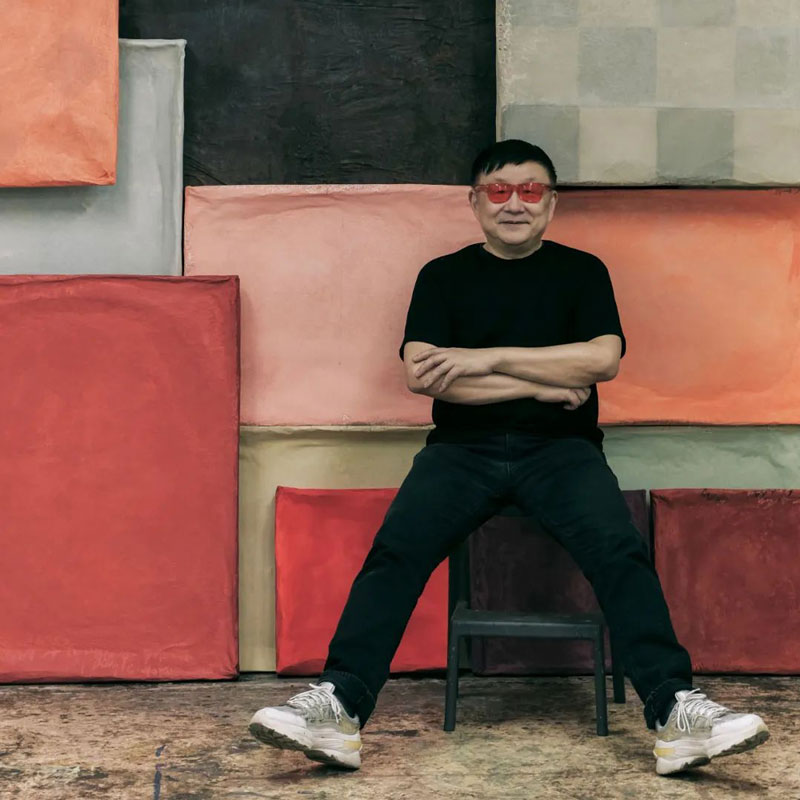1957年出生于中国上海,1981年毕业于上海轻工业专科学校(现为上海应用技术大学)。80年代以超现实主义和立体主义风格的绘画,在85新潮美术运动中崭露头角。90年代初前往比利时安特卫普皇家美术学院研究生院留学深造,并获得比利时卡雷尔·维斯拉特(Karel Veslat)艺术展一等奖。现任教于华东师范大学,工作和生活于上海。
德国艺术家约瑟夫·博伊斯“人人皆是艺术家”的艺术观念与热衷挑战西方绘画传统技法的欧洲现代艺术氛围,对留学初期的倪志琪而言尤为震撼。响应当时“反对一切经典”的观念,艺术家选择与国内截然不同的创作方式进行实验,使用集装箱、鸡蛋壳、凳子等任何能触及的材料,以“东方轮回再生”的方式创作装置艺术系列作品《蒙娜丽莎的再生》(1993)。1995年归国以后,传递朦胧感的主观视觉经验成为倪志琪的主要艺术特征。艺术家认为其创作有别于一般意义上的抽象绘画,而是侧重于对具体而实在的物体进行简化和提炼。任何宏大的具象系统结构都能通过他的艺术语言精炼为细微的物件,留存成带有细腻的触感、犹如碎片的记忆印象。
“我感觉许多艺术家都在根据自己的个性和特点来寻找不同的媒材进行创作。” 从留学比利时起的廿多年来,艺术家在布面油画创作之余,持续在各种特性的、带有文人气质且蕴含丰富历史沉淀的纸张中不断探索。在新近创作的《阿尔罕布拉宫》系列(2017)中,倪氏选用中国古法手工造纸覆盖于亚麻布面,以融合拼贴与绘画的方式,将画面分割构成无限延伸的瓷砖图形,回溯关于这座屹立在西班牙由中世纪摩尔人建造的红色宝殿的记忆。有时候艺术家还从欧洲建筑的残缺部分获取灵感进行艺术的再创作,并将欧洲特有的人文环境转化为自身的独特感性表达,在中国传统绘画技艺的帮助下彰显平实无华的气息。物质本质的提炼源自内心深处自然与平和的思想。作品褪去的颜色与粗糙的边缘所隐含的艺术内核,是带有东方人文关怀和关于时间记忆的思考。
Born in Shanghai, China in 1957, graduated from Shanghai Light Industry College (now Shanghai University of Technology) in 1981. In the 1980s, his paintings in the style of Surrealism and Cubism emerged in the 1985 New Wave Art Movement. In the early 1990s, he went to the Graduate School of the Royal Academy of Fine Arts in Antwerp, Belgium, to study abroad, and won the first prize in the Belgian Karel Veslat Art Exhibition. Currently teaching at East China Normal University, working and living in Shanghai.
When the artist first went abroad, he was shocked by Joseph Beuys’ “everyone is an artist” concept and the aggressive contemporary artistic environment at the time that challenged Western traditional techniques. This inspired him to experiment with artistic techniques that were extremely different from those that were predominant in China. He used anything he could find—such as containers, eggshells, chairs, etc.—as materials in his series of installation works called Mona Lisa’s Rebirth (1993), which centred around the Oriental concept of the cycle of life and renewal. When he returned to China in 1995, he began his lifelong artistic pursuit of achieving a misty and hazy atmosphere in his paintings. The streetscapes in his Scenery series (1999–2011) along with elements in his Portrait, Windows, and Chairs series (2011) seem to be concealed in half-transparent sunlight or mysteriously hidden behind frosted glass. Ni considers his works to be a special type of abstract painting that focuses on the simplification and extraction of a concrete and particular object. Even an enormous representational system can be simplified and portrayed as a close-up of one of its parts under his expression, retaining an emotional or tactile feeling or fragments of memories.
In Ni’s Alhambra series (2017), which combines both collage and paint, the artist has chosen to cover the canvas with a specific handmade paper produced by ancient and secretive Chinese papermaking techniques. The works focus on the Alhambra’s tile patterns and evoke a feeling of infiniteness while recalling memories of the red palace built by the Moors in Spain in the Middle Ages. With the help of Chinese traditional techniques, his gentleness and warmth are slowly revealed. The core concept hidden in the faded colour and rough edges of his works is a philosophical outlook on time and memories from an Asian perspective.




